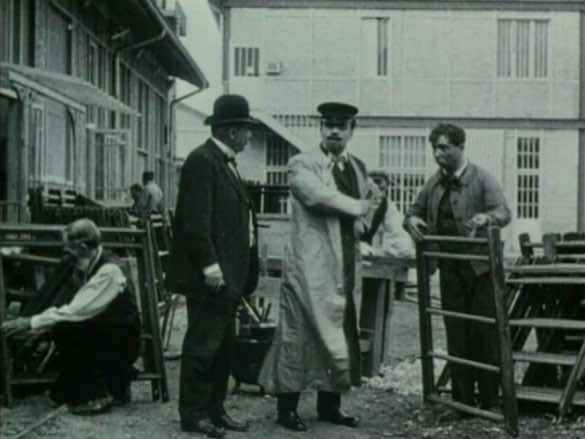LE CONTREMAÎTRE INCENDIAIRE
(Capo operaio incendiario /The Incendiary Foreman)
? (FR 1907)
Synopsis Following a dispute with one of his subordinates, and envious of his wealthy employer, one night the foreman of a film factory steals the money from the company safe and sets fire to the factory in such a way as to throw suspicion on the worker he argued with, who meanwhile has been sacked from his job. The intervention of the fire brigade and the police investigation bring the matter to an unforeseen conclusion.
This unusual short, a police procedural docu-fiction before its time, has a combination of features which makes it an exemplary compendium of silent film, both aesthetically and thematically. Its main event, a fire, is not staged – the Pathé cameramen evidently were on the scene to film a real fire as it occurred. The fire wagons pulled by galloping horses, the frantic firemen busy around the hydrants, the fearsome black smoke, the devastation – all combine to create a dramatically realistic atmosphere which contrasts with the fictional mechanism of the culprit’s discovery.
Generally remembered as the “primary collective trauma” of cinema history is the tragic blaze (over 120 dead) at the Bazar de la Charité, a charity fair which was being held in a temporary wooden structure with canvas stalls in the 8th arrondissement in Paris on 4 May 1897. The fire started in a small room used for the projection of moving pictures with technology invented by the Lumière brothers. Remarkably, it was caused not by the spontaneous combustion of nitrocellulose film, but the explosion of ether in the lamp ignited by the unfortunate projectionist. Henceforth fires in picture houses and film factories caused by nitrate combustion were the occurrences the most feared (and not infrequent) by people who had to work with that dangerous material. It was no coincidence that Charles Pathé advocated the development of cellulose acetate “safety” film in those days. In his 1937 autobiography he wrote, “…the entire cinema world had its eyes fixed on our workshops, our processes, our equipment”.
This short film thus stands as a specimen of metacinema, locating the basic story in a film factory, and alternating shooting in real exterior locations with interior scenes in sets depicting the factory office and the wealthy employer’s house. With scenes recalling the Lumières’ historic Sortie d’usine (Workers Leaving the Factory), it is also one of the first films to bring to the screen waged human labour and its hierarchies, and the potential effects of the industrial powers of modernity.
The film’s restoration has brought the vivid original colours of the blazing fire scenes back to life – a further quality that places it among the Cineteca Italiana’s unacknowledged gems.
Luisa Comencini

cast: ?.
prod: Pathé Frères.
uscita/rel: 21.12.1907 (Le Cirque d’Hiver, Paris).
copia/copy: 35mm, 250 m. (orig. 270 m.), 14′ (16 fps), col. (imbibito/tinted); did./titles: ITA.
fonte/source: Cineteca Italiana, Milano.
Restauro/Restored: 2009, da un 35mm positivo nitrato/from a 35mm nitrate print.


 Italiano
Italiano